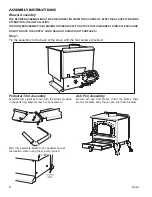
3
18. The special paints used on your stove may give off some smoke and an odor while they are curing during the
fi
rst
12 to 15
fi
res. Additional smoke and odor may be emitted from the light oils used in construction of the
fi
re box. This
should disappear after a short period of time and not occur again. Persons with lung conditions or owners of susceptible
domestic pets (such as birds) should take prudent precautions. Open windows and doors as needed to clear smoke
and/or odor. Paint discoloration will occur if the stove is over
fi
red.
19. This stove has a painted surface which is durable but it will not stand rough handling or abuse. When installing your
stove, use care in handling.
20. CLEAN STOVE FREQUENTLY
as soot, creosote and ash may accumulate. Clean exterior with soap and warm water
when stove is not hot. Do not use any acids or scouring soap, as these solvents wear and dull the
fi
nish.
21. ALERT ALL PERSONS TO THE HAZARDS OF HIGH SURFACE TEMPERATURES
while stove is in operation –
especially young children. Keep away from a hot stove to avoid burns or clothing ignition.
22. NEVER LEAVE SMALL CHILDREN UNSUPERVISED WHEN THEY ARE IN THE SAME ROOM AS THE STOVE.
If
small children will be in the same room as the stove during operation, provide a sturdy barrier to keep them at a safe
distance from the stove.
23. Keep stove area clear and free from all combustible materials, gasoline, engine oil, naphtha and other
fl
ammable
vapors and liquids.
24. WHILE TENDING THE FIRE ALWAYS WEAR PROTECTIVE CLOTHING
,
fi
re retardant hearth gloves and eye
protection, to prevent burns.
25. Never operate this stove with the door open except when re-fueling. Such actions can result in very dangerous operating
conditions.
26. DO NOT OVER FIRE THE STOVE
. Over
fi
ring will occur if combustion air is uncontrolled as when feed door is left
open during operation. Such actions can result in very dangerous operating conditions. While in operation, keep the
feed door closed and secured at all times except while tending the
fi
re
27. When adding fuel be careful not to smother the
fi
re. Do not build
fi
res against glass and do not load fuel to a height or
in such a manner that it creates a hazard when opening the door.
28. NEVER LEAVE THE STOVE UNATTENDED
with door open. Always close the door after ignition.
29. DO NOT CONNECT TO OR USE IN CONJUNCTION WITH ANY AIR DISTRIBUTION DUCT WORK UNLESS
SPECIFICALLY APPROVED FOR SUCH INSTALLATIONS
.
30. A WOOD-BURNING STOVE MUST NEVER BE INSTALLED IN A HALLWAY OR NEAR A STAIRCASE
, as it may
block egress in the event of a
fi
re.
31. DO NOT INSTALL IN A SLEEPING ROOM. DO NOT INSTALL IN AN ALCOVE OR INSIDE A FIREPLACE
.
32. Install at least one smoke detector on each
fl
oor of your home. Detectors should be located away from the heating
appliance to avoid false alarms. Detectors should be located close to sleeping areas. Follow the smoke detectors
manufacturer’s placement and installation instructions. Maintain smoke detector per manufacturer’s instructions.
33. CARBON MONOXIDE (CO) HAZARD
. A buildup of CO fumes is toxic and can be fatal. Carbon Monoxide is a colorless,
odorless gas produced during combustion of wood, coal, oil, gas and by other fuel burning appliances. It is important
to have a proper draft and adequate replacement air ventilation so fumes are drawn out the chimney. Installed as
instructed this stove is designed to be as safe as possible yet it is recommended to install a CO detector. Follow the
manufacturer’s recommendations for proper installation and use. It is recommended to be placed at table-top level
(not near the ceiling) to avoid false alarms. Realize that devices other than a stove (i.e. motor exhaust) can trigger
CO alarms.
If alarm sounds:
•
Recognize the symptoms of CO poisoning (headaches, nausea & drowsiness).
•
Increase ventilation (open windows & doors).
•
Make sure stove doors and/or lids are closed and secured.
•
Check stove for smoking or puf
fi
ng (open air
fl
ow controls).
•
Check chimney & connector pipe for leaks, blockage or down-draft conditions.
•
Check CO device for false alarm.
34. Keep power cords, electrical appliances and/or assemblies outside of the clearance area shown in this manual for
combustible materials.
35. Consult your municipal building department or
fi
re of
fi
cials about restrictions, permits and installation requirements
for your area.
36. For further information on using your stove safely, obtain a copy of the National Fire Protection Association (NFPA)
publication, “Using Coal and Wood Stoves Safely” NFPA No. HS-10-1978. Write NFPA, Batterymarch Park, Quincy,
MA 02269.
SAFETY INSTRUCTIONS




































